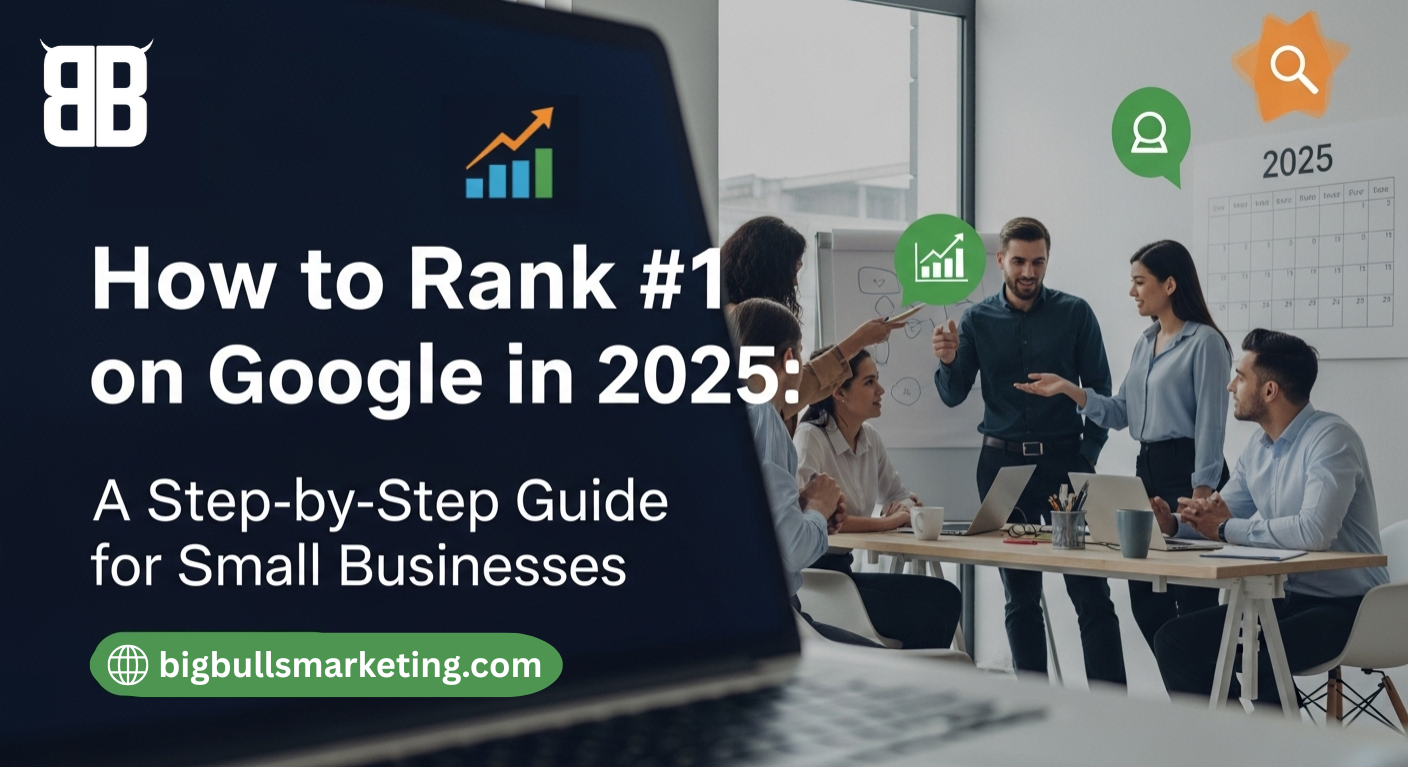In today’s digital-first world, appearing at the top of Google’s search results is no longer a luxury—it’s a necessity. For small businesses in 2025, ranking #1 on Google can be the difference between struggling to get leads and enjoying consistent growth. But with constant algorithm updates, AI-powered search, and shifting consumer behavior, how can your business actually climb to the top?
At Big Bulls Marketing, we specialize in helping small businesses achieve measurable digital success. In this step-by-step guide, we’ll break down the exact strategies you can use to rank higher on Google in 2025—without wasting your budget or time.
Why Ranking #1 on Google Matters in 2025
Before diving into the steps, let’s quickly understand why ranking #1 is so important:
- 70% of clicks go to the first three results on Google.
- Voice search and AI assistants now prioritize the most authoritative result.
- Trust and credibility come automatically when your brand ranks first.
- Higher ROI compared to traditional ads.
Simply put, the higher you rank, the more visibility, leads, and revenue your business generates.
Step 1: Understand Google’s E-E-A-T Principles
Google’s algorithms in 2025 focus heavily on E-E-A-T:
- Experience: Have you demonstrated first-hand knowledge?
- Expertise: Are you an expert in your niche?
- Authoritativeness: Do other websites trust and link to you?
- Trustworthiness: Is your site secure and credible?
👉 To rank #1, create high-quality, user-first content that reflects these principles. Case studies, reviews, and real-world examples will boost your authority.
Step 2: Perform Smart Keyword Research
Keyword research remains the backbone of SEO. However, in 2025, you need to focus on:
- Long-tail keywords (e.g., “best digital marketing agency for small businesses in 2025”).
- Conversational search queries (optimized for AI chatbots and voice search).
- Search intent (informational, navigational, transactional).
Use tools like Google Keyword Planner, SEMrush, or Ahrefs to identify keywords with high intent and lower competition.
Pro Tip: Target local SEO keywords such as “best bakery in Delhi” if you run a location-based business.
Step 3: Optimize On-Page SEO
Once you know your keywords, apply them strategically. On-page SEO in 2025 includes:
- Optimized Title Tags & Meta Descriptions – Include your main keyword naturally.
- Header Tags (H1, H2, H3) – Structure content for readability and search.
- Image SEO – Use descriptive file names and alt tags.
- Internal Linking – Connect related pages for stronger authority.
- Schema Markup – Enhance your chances of appearing in rich snippets.
Remember: Google favors user-friendly websites, so don’t overstuff keywords.
Step 4: Invest in High-Quality Content
Content is still king—but in 2025, context is queen. To rank #1:
- Publish long-form blogs (1,000–2,000 words) targeting a main topic.
- Create AI-friendly content that answers common questions concisely.
- Use visuals, infographics, and videos to improve engagement.
- Update existing content regularly with fresh stats and insights.
At Big Bulls Marketing, we recommend a content calendar to maintain consistency.
Step 5: Improve Website User Experience (UX)
Google rewards websites that keep users happy. Focus on:
- Mobile-first design – Over 70% of searches happen on mobile.
- Fast loading speed – Aim for under 2 seconds.
- Easy navigation – Ensure users find what they need quickly.
- Secure browsing (HTTPS) – Builds trust and credibility.
A poor user experience increases bounce rate, which hurts rankings.
Step 6: Build High-Quality Backlinks
Backlinks remain one of the most important ranking signals. In 2025:
- Focus on quality over quantity.
- Build relationships with niche-relevant websites.
- Guest post on authoritative blogs.
- Earn links through original research and case studies.
Avoid spammy backlink tactics—they can penalize your site.
Step 7: Leverage AI & Voice Search Optimization
With the rise of Google’s AI Overviews and voice search, small businesses must optimize differently:
- Use natural, conversational language.
- Answer FAQs directly in your content.
- Structure content in short, scannable paragraphs.
- Implement structured data for better AI understanding.
Example: Instead of just “best coffee shop,” optimize for “Where can I find the best coffee shop near me open now?”
Step 8: Focus on Local SEO
If you’re a small business, local SEO is your best weapon. Steps include:
- Claim and optimize your Google Business Profile.
- Get positive customer reviews.
- Add NAP (Name, Address, Phone Number) consistently across directories.
- Use local keywords like “plumber in Bangalore.”
Local SEO helps you rank in Google’s Map Pack, which drives huge local traffic.
Step 9: Track & Measure Results
Ranking #1 requires consistent monitoring. Use:
- Google Analytics 4 (GA4) for traffic analysis.
- Google Search Console for keyword rankings.
- SEO tools for backlink tracking.
Regularly measure progress and refine your strategy.
Step 10: Stay Updated with SEO Trends
Google’s algorithms evolve constantly. Trends to watch in 2025 include:
- AI-powered search integration.
- Video SEO growth (YouTube & TikTok ranking in Google).
- Sustainability-focused content gaining traction.
- Personalized search results based on user behavior.
Following industry updates keeps your business ahead of competitors.
Conclusion
Ranking #1 on Google in 2025 isn’t about shortcuts or hacks—it’s about building long-term authority, creating valuable content, and optimizing for user experience.
As a small business, you may not have the massive budgets of big corporations, but with the right SEO strategy, you can still dominate your niche.
At Big Bulls Marketing, we help businesses like yours turn clicks into customers. If you want to rank #1 on Google in 2025, it’s time to start now.
FAQs
Q1. How long does it take to rank #1 on Google in 2025?
Ranking time depends on competition and SEO efforts. On average, it takes 3–6 months for small businesses to see noticeable results.
Q2. Is SEO still worth it in 2025?
Yes! SEO remains one of the highest ROI marketing strategies, especially with AI-driven search making organic visibility more valuable.
Q3. Can I rank #1 without backlinks?
Backlinks are still crucial, but you can rank for low-competition, long-tail keywords without many backlinks if your content is high quality.
Q4. What’s the difference between SEO and paid ads?
SEO drives long-term organic growth, while paid ads bring instant but temporary traffic. The best results come from combining both.
Q5. Do I need professional help for SEO?
DIY SEO works for beginners, but hiring experts like Big Bulls Marketing ensures faster, more sustainable results with fewer mistakes.



Leave a Reply